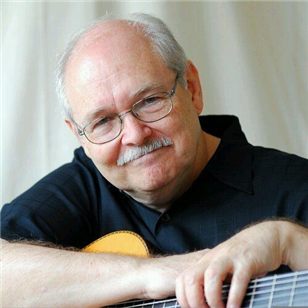Guitar by Randy Buckner
John Knowles: Part Three - Reflections
Sunday, September 8, 2019 by Randy Buckner | Method Books
Chet Atkins, The Person
Looking back, John Knowles remembers Chet Atkins as being a person who wanted to "get down to business."
When Atkins handed Knowles a guitar, he said, "Show me what you're working on" - meaning, "Let's get busy."
Atkins didn't want "to be on anybody's pedestal, he wanted to be a guitar player, and get to work."
But Atkins would also take time to make a five-year old feel special.
The day of the editing session, Atkins had a lunch appointment with - author and songwriter - Shel Silverstein.
When Shel arrived at Atkins' office, Knowles' son - Jay, who had been sitting quietly in Atkins' office - became very excited. Jay looked at his dad and said, "Don't you think we ought to sing one of our songs for Chet and Shel?"
Atkins and Silverstein sat back down, and listened to father and son sing. Atkins asked them to sing the song a second time, so he could record it on a portable cassette player.
Taking out a pen to write on the cassette, Atkins asked Jay the name of the song.
"The Gorilla Song," Jay said. Atkins asked if they wrote it. "Yes" Jay said. When asked if his name came first in the songwriting credits, the boy replied "yes."
Knowles said he knew Atkins was a good guy, but didn't know how deep it ran until he saw Jay being treated as a professional by his hero.
The Book
Coming from a background of classical guitar music - where students learned from printed music and teachers - Knowles "envisioned a day you could do the same with Atkins, Joe Pass, or Johnny Smith."
This led Knowles to become an early advocate for getting serious about publishing Atkins' music.
Knowles feels in the history of "how to" guitar books, "Chet Atkins Note-for-Note" was an early effort to take complex guitar music and have it "be the real thing instead of a fake approximation."
It's Affect on Guitarists
The first time Knowles heard someone play a song learned from the book, he almost went up and introduced himself. Instead, he thought, "next time...I'll do that, but this time is for me. So I kept that moment for myself. Next time...I'll ask what they learned from [the book]."
Knowles has been praised by musicians who say the book helped "decode" Atkins' music. For example, his harmonics, open string runs, and intricate scales like the one used in "Emily."
Final Thoughts
Knowles reflects, "It looked pretty nuts when I was doing the book. I was up all night transcribing, while teaching at a music store and community college during the day. I had no idea [the project] would lead where it's led."
"I just put my head down, did the work...looked up, and people all over the world wanted to know who John Knowles was because he wrote this book."
Knowles knew he was "gifted" with the opportunity to work with Atkins. He felt the obligation to "share what I had learned from that encounter."
Knowles hopes the project stands up over time. As he told me, "I felt I was given the chance to write the book I wish I could have bought when I was a kid."
Randy Buckner.
Hoover Music Co.
Springfield, Mo.
www.bucknerguitar.us


